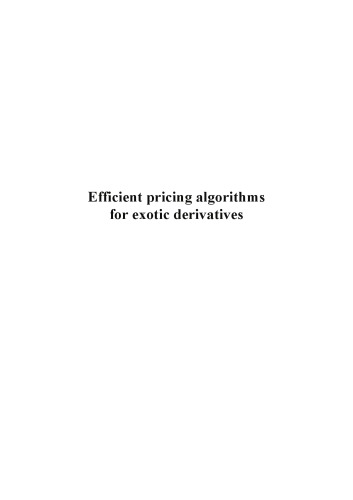

Most ebook files are in PDF format, so you can easily read them using various software such as Foxit Reader or directly on the Google Chrome browser.
Some ebook files are released by publishers in other formats such as .awz, .mobi, .epub, .fb2, etc. You may need to install specific software to read these formats on mobile/PC, such as Calibre.
Please read the tutorial at this link: https://ebookbell.com/faq
We offer FREE conversion to the popular formats you request; however, this may take some time. Therefore, right after payment, please email us, and we will try to provide the service as quickly as possible.
For some exceptional file formats or broken links (if any), please refrain from opening any disputes. Instead, email us first, and we will try to assist within a maximum of 6 hours.
EbookBell Team

0.0
0 reviews
ISBN 10: 9051709094
ISBN 13: 978-9051709094
Author: ROGER LORD
When I started thinking about pursuing a PhD in mathematical finance, it was soon clear to me
that I wanted to combine academia with the financial industry. The combination of Erasmus
University Rotterdam, where Antoon Pelsser was my supervisor, and the Derivatives Research &
Validation Team at Rabobank International enabled me to do this. I would like to take this
opportunity to thank Antoon for his guidance.
At Rabobank International I am particulary indebted to Sacha van Weeren and Maarten
Rosenberg for creating my position. I would like to thank Sacha for the stimulating environment
his team provided, the pointers to many good articles, and especially for the fact that, while
annoying at the time, he made me explain every step in every derivation I made.
I will now chronologically walk through the various chapters of this thesis, and thank
everyone where thanks are due. Without a doubt I will in the process forget some people – they
are thanked too. Initially the focus of my thesis was meant to be on exotic interest rate
derivatives, but my interests drifted when Jeroen van der Hoek, a former colleague from Cardano
Risk Management, pointed me towards Curran’s approximation for Asian options. This led to the
foundation of Chapter 7, for which I thank Jeroen.
The next chapter was inspired by a presentation Antoon Pelsser gave at the Unfinished
Manuscripts seminar in Rotterdam. This eventually led to our joint publication in Chapter 8. I
would like to thank Antoon for his ideas for this paper and the opportunity he gave me to present
out work at the Quantitative Methods in Finance conference in Sydney.
Somewhere along the line I came into contact with Christian Kahl, with whom it was an
honour and great pleasure to work. I would like to take this opportunity to thank Christian for the
many ideas we generated in Amsterdam and Wuppertal, which resulted in Chapters 3 and 4, and
also for the invaluable feedback he has given on Chapter 6.
The final two chapters, chronologically that is, Chapters 5 and 6, would certainly have been
different had I not been allowed to supervise students, both at the university and at the bank.
Thanks go out to all my students. Three of them I will mention by name. Firstly ManWo Ng,
whose Master’s thesis was an inspiring first look at topics covered in Chapters 3 and 4. Secondly
Frank Bervoets, whose work inspired the CONV method in Chapter 5. And finally, Remmert
Koekkoek, without whom the full truncation method from Chapter 6 would never have existed. I
am also grateful to my other co-authors, Kees Oosterlee and Fang Fang in Chapter 5, and Dick
van Dijk in Chapter 6, who I also thank for the great opportunity he gave me to attend the Fourth
World Congress of the Bachelier Finance Society in Tokyo.
In general I am grateful to the Econometric Institute and the Tinbergen Institute for their
financial support, which enabled me to attend several conferences. I am much obliged to several
people at Erasmus University Rotterdam: Antoon Pelsser, Martin Martens and Dick van Dijk for
allowing me to teach several courses on risk management and option pricing, Michiel de Pooter
and Francesco Ravazzolo for creating a pleasant atmosphere when I was in Rotterdam, and
finally the secretarial staff from both the Econometric Institute and the Tinbergen Institute for
their assistance.
Chapter1 : Introduction
Chapter 2: Content
Chapter 3: Conclusion
Chapter 4: Appendices
Chapter 5: Glossary
Chapter 6: References
Chapter 7: Index
efficient pricing of derivatives on assets with discrete dividends
machine learning for derivatives pricing
pricing derivatives pdf
pricing exotic options
an empirical analysis of algorithmic pricing on amazon marketplace